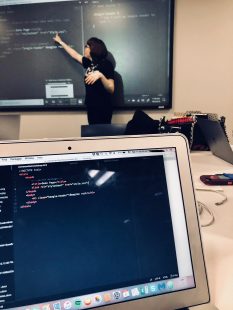As a part of the Rewriting the Code initiative, the Creative Technology Cohort, which encourages W&L women to explore opportunities at the intersection of technology and the humanities, convened for the first of its fall workshops on Saturday, October 6th. Taught by Katherine Donnally, artist and web designer and developer, the “How the Web Works” workshop covered the basics of web design, HTML and CSS and introduced the women to working with their own web domains for personal or professional websites.
Aiming to teach the web in the way she wished she had learned it, Katherine explained the unfamiliar tech language that was made up just twenty years ago, acknowledged the complexities of web design and development by emphasizing that we were capable of understanding it, and encouraged us from the start to seek clarification on anything we did not immediately understand. Katherine, who learned HTML just one and a half years ago and now works as a web developer with a client base, also noted that, because a webpage contains only three elements, it’s really learnable and worth it to learn each element considerably well.
She explained that a website is simply text and introduced the basic ingredients in a webpage: HTML (which function as the buckets for text), CSS (which acts like paint-by-numbers instructions that make the page visually appealing), and the Browser (which is the text reader that executes these instructions). HTML, which stands for Hypertext Markup Language, comes from a consistent set of rules to which web developers agree that results in the words and structure that form a webpage. CSS, which stands for Cascading Style Sheets, defines a language that dictates instructions for the style and design of the webpage. Playing with the style elements in CSS is like “undoing art,” Katherine noted because web designers can easily try out different colors, fonts and layouts until they find the perfect design. She continued, “Paper doesn’t forget, but webpages forget really easily,” permitting quick alterations and numerous possibilities. Identifying these ingredients, Katherine explained that all that web design is and all we were doing was writing things in a way that computers understand.
 After a break for lunch of delicious chili and corn muffins, Professor Bufkin led the Cohort in exploring what having our own web domains entails and the options before us. She showed us how to use a CMS (Content Management System), which renders the desired content on the webpage, displaying it on a browser. Using a CMS, specifically WordPress, was extremely useful for our purposes because it was a simple way to get content on the web and the page up and running while working on HTML and CSS locally. WordPress allows web designers to use HTML in the text editor for posts or pages and customize additional CSS, allowing us to continue to experiment with HTML and CSS while we take advantage of the structure it provides for our websites without having to create our website from scratch. As we experimented with our websites, we considered important questions for web design, including what kind of pages do I need? How will users navigate my website? What kind of content will be on my webpage? Mostly photos or will I want writing? If I include a lot of writing, how should I use the white space on the page? What fonts should I use? The decisions and possibilities behind designing and customizing a webpage seemed endless.
After a break for lunch of delicious chili and corn muffins, Professor Bufkin led the Cohort in exploring what having our own web domains entails and the options before us. She showed us how to use a CMS (Content Management System), which renders the desired content on the webpage, displaying it on a browser. Using a CMS, specifically WordPress, was extremely useful for our purposes because it was a simple way to get content on the web and the page up and running while working on HTML and CSS locally. WordPress allows web designers to use HTML in the text editor for posts or pages and customize additional CSS, allowing us to continue to experiment with HTML and CSS while we take advantage of the structure it provides for our websites without having to create our website from scratch. As we experimented with our websites, we considered important questions for web design, including what kind of pages do I need? How will users navigate my website? What kind of content will be on my webpage? Mostly photos or will I want writing? If I include a lot of writing, how should I use the white space on the page? What fonts should I use? The decisions and possibilities behind designing and customizing a webpage seemed endless.
A day of HTML, CSS and chili, the “How the Web Works” Women and Technology Workshop fostered a supportive environment and a collaborative group of women that I truly enjoyed. I appreciated the opportunity to expand my knowledge of web development and consider new questions and ideas as I embark on creating my own website.
-Jenny Bagger ’19, DH Undergraduate Fellow